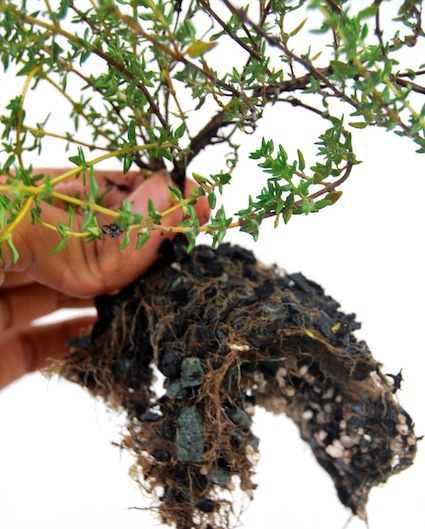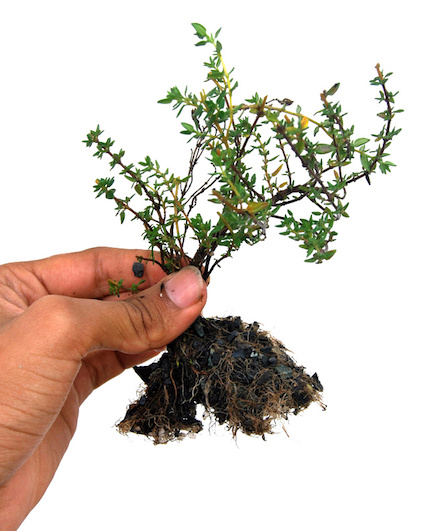Thyme bonsai trees need well-drained soil and plenty of sunlight. Water them moderately and prune regularly to maintain shape.
Caring for a thyme bonsai tree involves specific attention to soil, sunlight, and watering needs. These miniature trees thrive in well-drained soil and require ample sunlight to grow healthily. Watering should be done moderately, ensuring the soil is moist but not waterlogged.
Pruning is essential to maintain the desired shape and promote new growth. Regularly check for pests and diseases to keep your thyme bonsai in optimal condition. With proper care, a thyme bonsai can be a beautiful and fragrant addition to your indoor or outdoor garden.

Credit: www.bonsaiempire.com
Introduction To Thyme Bonsai
Thyme bonsai is a small, aromatic plant. It is ideal for indoor gardens. Many people love its fragrance and beauty. Thyme is not only pretty but also useful. It is often used in cooking. Thyme bonsai is easy to care for. It does not need much water. It grows well in sunny spots. Thyme bonsai is perfect for beginners. It can live for many years with proper care.
History And Origin
Thyme comes from the Mediterranean region. Ancient Greeks and Romans used thyme. They believed it brought courage and strength. Thyme was also used in medieval Europe. People used it to ward off evil spirits. Today, thyme is popular worldwide. Thyme bonsai combines history and art. It brings a piece of the past into your home.
Popular Varieties
| Variety | Description |
|---|---|
| Common Thyme | Most popular. Has small, green leaves. |
| Lemon Thyme | Has a lemon scent. Great for cooking. |
| Silver Thyme | Features silver-edged leaves. Very decorative. |

Credit: www.bonsaiempire.com
Choosing The Right Thyme Bonsai
Healthy thyme bonsai plants have vibrant green leaves. Avoid plants with yellow or brown spots. Check the soil for good drainage. Healthy roots are firm and white. Gently tug the plant to check the roots.
Some thyme varieties are perfect for beginners. Lemon thyme is easy to grow. English thyme is also beginner-friendly. Both varieties are hardy and forgiving. They can thrive in various conditions.
Planting And Potting Thyme Bonsai
The best soil mix for Thyme Bonsai should be well-draining. A good mix includes sand, perlite, and organic matter. This combination ensures the roots get enough air and water. Avoid using heavy clay soils. They retain too much moisture and can cause root rot.
Choosing the right pot is essential for Thyme Bonsai. The pot should have drainage holes. This helps to prevent waterlogging. It should be shallow but wide enough for the roots. A ceramic or terracotta pot is ideal. These materials allow for better air circulation. Ensure the pot is sturdy and can support the plant’s growth.
Watering And Humidity Needs
Thyme bonsai trees thrive with moderate watering, ensuring the soil remains slightly moist but never waterlogged. Maintaining proper humidity levels helps keep the foliage healthy and vibrant.
Proper Watering Techniques
Water your Thyme Bonsai when the soil feels dry. Use a watering can with a fine nozzle. This helps to avoid washing away the soil. Water until it runs out of the drainage holes. Always use room temperature water. Cold water can shock the roots.
Maintaining Humidity
Thyme Bonsai trees love humid environments. Place a humidity tray under the pot. Fill the tray with water but do not let the pot sit in water. Mist the leaves daily to keep humidity levels high. Avoid placing the tree near heaters or air conditioners.
Pruning And Shaping Techniques
Prune your Thyme bonsai tree regularly. Use sharp, clean scissors for the best results. Cut back any dead or yellow leaves. Trim the tips of new growth to encourage a bushier shape. Always prune just above a leaf node. This helps the tree to grow more evenly. Do not remove more than one-third of the plant at a time. This can stress the tree and slow its growth.
Advanced shaping can create unique bonsai styles. Use wire to shape branches. Wrap the wire around the branch gently. Bend the branch slowly to avoid breaking it. Remove the wire after a few months. The branch should hold its new shape. You can also use weights to pull branches down. This helps create a more natural look. Always monitor the tree for signs of stress. Adjust your techniques as needed.

Credit: m.youtube.com
Fertilizing Thyme Bonsai
Thyme bonsai trees thrive with organic fertilizers. Liquid fertilizers work best. Choose those rich in nitrogen, phosphorus, and potassium. Avoid chemical fertilizers. They can harm the delicate roots. Fish emulsion and seaweed extract are great choices. They provide essential nutrients.
Feed your thyme bonsai every two weeks during the growing season. Reduce feeding to once a month in winter. Always dilute the fertilizer. Strong solutions can burn the roots. Water the plant before feeding. This helps nutrients absorb better. Stick to a consistent schedule. Regular feeding promotes healthy growth.
Managing Pests And Diseases
Maintaining a healthy Thyme Bonsai Tree involves regular monitoring for pests and diseases. Ensure proper airflow and avoid overwatering to prevent common issues.
Common Pests To Watch For
Thyme bonsai trees often attract aphids and spider mites. These pests can damage the leaves. Look out for whiteflies too. They are tiny but harmful. Mealybugs can also be a problem. Check the leaves for webbing. Webbing means spider mites are present.
Preventive Measures
Keep your bonsai tree clean. Remove dead leaves often. Spray the tree with water. This helps remove small pests. Use neem oil to keep bugs away. Neem oil is safe for plants. Inspect the tree every week. Early action stops pests from spreading.
Seasonal Care And Maintenance
Thyme bonsai trees thrive with seasonal care and maintenance. Prune regularly and adjust watering based on seasonal changes. Ensure adequate sunlight and protect from frost during colder months.
Winter Protection
Thyme bonsai trees need extra care in winter. Keep the tree indoors during freezing temperatures. Place it near a window with bright, indirect light. Avoid direct heat sources like radiators. Water the tree less often but don’t let the soil dry out completely. Use a humidity tray to maintain moisture levels around the tree.
Summer Care Tips
In summer, thyme bonsai trees thrive outdoors. Make sure they get enough sunlight. Water the tree more often as the soil dries out faster. Use well-draining soil to prevent root rot. Prune the tree regularly to maintain its shape. Fertilize the tree every two weeks with a balanced fertilizer.
Troubleshooting Common Issues
Yellowing leaves can mean many things. It often shows overwatering or underwatering. Check the soil. If it is too wet, let it dry out. If it is too dry, give the plant a good drink. Nutrient deficiency can also cause yellow leaves. Use a balanced fertilizer. Another reason could be poor lighting. Make sure your bonsai gets enough light.
Stunted growth is a sign of problems. Lack of nutrients can slow growth. Use a good fertilizer. Poor soil quality can also affect growth. Use well-draining soil. Inadequate sunlight is another issue. Place your bonsai in a sunny spot. Root-bound plants can also have stunted growth. Check the roots and repot if needed. Ensure the new pot is not too big.
Conclusion And Final Tips
Caring for a Thyme Bonsai Tree involves regular pruning, proper sunlight, and well-drained soil. Ensure consistent watering to keep the soil moist but not waterlogged.
Long-term Care Insights
Thyme bonsai trees need regular watering. Use a spray bottle to mist the leaves. Water the soil when it feels dry. Keep the tree in a sunny spot. Thyme bonsai loves sunlight.
Prune the tree to maintain its shape. Use sharp scissors for clean cuts. Remove dead leaves and branches. This helps the tree stay healthy. Fertilize the tree every two weeks. Use a balanced liquid fertilizer.
Encouraging Continuous Growth
Repot the thyme bonsai every two years. Use fresh soil for better growth. Trim the roots during repotting. This encourages new root growth. Check for pests regularly. Use natural remedies to remove them.
Rotate the tree occasionally. This ensures even growth on all sides. Keep the bonsai in a place with good air circulation. This prevents mold and fungal issues. Enjoy the beauty of your thyme bonsai as it grows.
Conclusion
Caring for a thyme bonsai tree is rewarding and simple. With proper light, water, and pruning, it thrives. Enjoy the fragrant leaves and unique beauty of this miniature tree. Regular attention ensures its health and longevity. Start your thyme bonsai journey today and watch your plant flourish.

